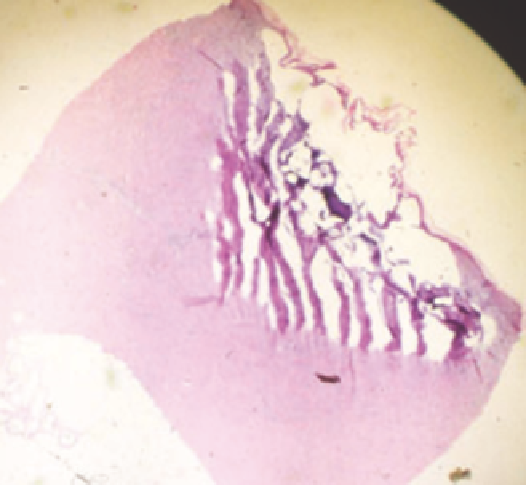Biomedical Engineering Reference
In-Depth Information
Figure 1.25
Full-thickness necrosis in ex vivo sample after multiple pulses of
a neodynium:yttrium-aluminum-garnet laser.
elevation in the skin, and with repeated laser impacts,
because of the slow cooling of this volume (large
t
),
catastrophic pancutaneous thermal damage is pos-
sible. We observed this phenomenon when treating
a piece of discarded tissue after Mohs surgery. After
exposing the tissue to one, three, and six repeated
exposures of Nd:YAG laser at 1 Hz, we noted wide-
spread coagulation that occurred as an “all-or-none”
phenomenon between the third and sixth pulses,
consistent with the threshold behavior of protein
denaturation (Fig. 1.25). This wavelength (1064 nm)
represents the extreme example of a “what you don't
see can hurt you laser” (20). They are extremely
useful, but the user must develop an understanding
of where this energy is going to effectively harness
it and benefi t his patients. One can appreciate fi rst-
hand that the Nd laser penetrates deeply by taking
a fi ngertip on one side of the ear and applying the
laser to the opposite side of the lobe. The author
promises a hot fi nger!
6.
MIR lasers and deeply penetrating lamps
: these la-
sers and lamps heat tissue water. Depending on
where we want to heat, we can “choreograph” our
laser and/or cooling settings to maximize the skin
temperature in certain bands. In general, with more
deeply penetrating wavelengths, larger volumes
are heated. On the other hand, achieving tempera-
ture elevations in the volume will require higher
fl uences than with highly absorbing wavelengths.
With more highly absorbing wavelengths, one will
heat a tighter band of dermis. This is referred to as
selective dermal heating. Accordingly, without sur-
face cooling, unless very small fl uences are applied,
a top to bottom thermal injury occurs (Fig. 1.26).
The absorption coeffi cients for the 1320, 1450, and
1540 nm systems are ~3, 20, and 8 cm
−1
, respectively
(67,68), whereas the effective scattering coeffi cients
are about 14, 12, and 11 cm
−1
. The corresponding
penetration depths are ~1500, 300, and 700
Figure 1.26
Effect in pigskin of a 1540-nm laser with a 2.5-mm spot without
cooling and fl uence of ~15 J/cm
2
.
the 1450-nm laser, followed by the 1540- and 1320-nm
lasers. The advantage of deeper penetration (i.e., less
absorption) is that surface cooling does not need to
be as aggressive. On the other hand, higher fl uences
must be applied and the peak temperature elevation
will tend to be slightly deeper. Newer deeply pen-
etrating lamps have been introduced (Titan, Cutera,
Brisbane, California, USA). They emit light over a
1- to 2-
m band with relatively low power densi-
ties and long exposures (several seconds). In a typi-
cal scenario, the irradiation begins after a roughly
2-second period of cooling. At this point, a band of
tissue from roughly 700-
μ
m deep to 1.5-mm deep in
the skin is heated. By varying the fl uence, this rela-
tively large volume can be heated to different peak
temperatures (Fig. 1.27). As part of each iteration,
post-pulse cooling is included. This is because such a
large volume of skin is heated that a “thermal wake”
of several seconds is created. It follows, that if one
removes the handpiece too quickly, there is a ten-
dency for heat to build up near the skin surface with
the possibility of pain, dermal thermal injury, and
scarring. One can make various arguments for large-
volume deep subsurface heating versus heating a
precise band of dermis more superfi cially (i.e., the
deep papillary or superfi cial reticular dermis).
As one attempts to confi ne heat superfi cially, a more
highly water absorbing MIR laser is optimal, but the
counterpoint is that the cooling must also be con-
fi ned superfi cially. It follows that, as one tries to heat
superfi cially and spare the epidermis, the heating-
cooling tandem must become ever more synchro-
nized, lest one overheat the epidermis or overcool
the dermis. On the other hand, with more penetrat-
ing wavelengths, heating will occur in the deeper
dermis, often below the level of solar elastosis, the
very pathology we presumably are trying to reverse.
μ
m.
It follows that for equal surface cooling and equal
fl uences, the most superfi cial heating will occur with
μ

















